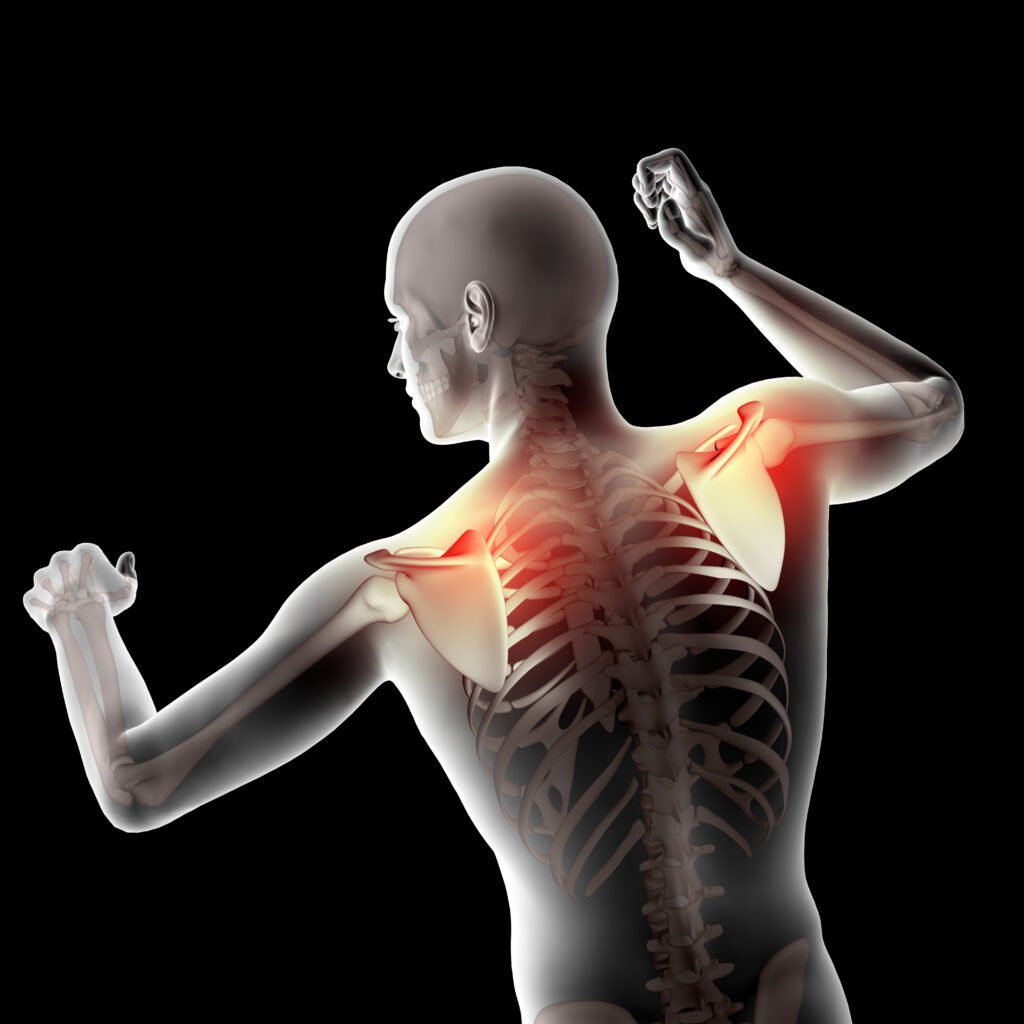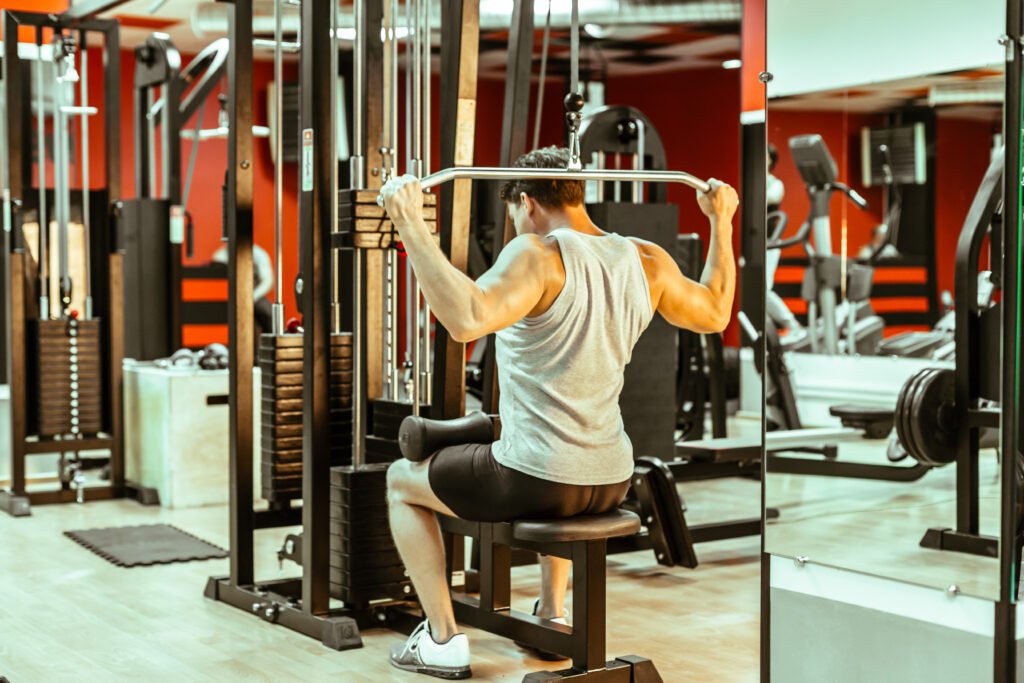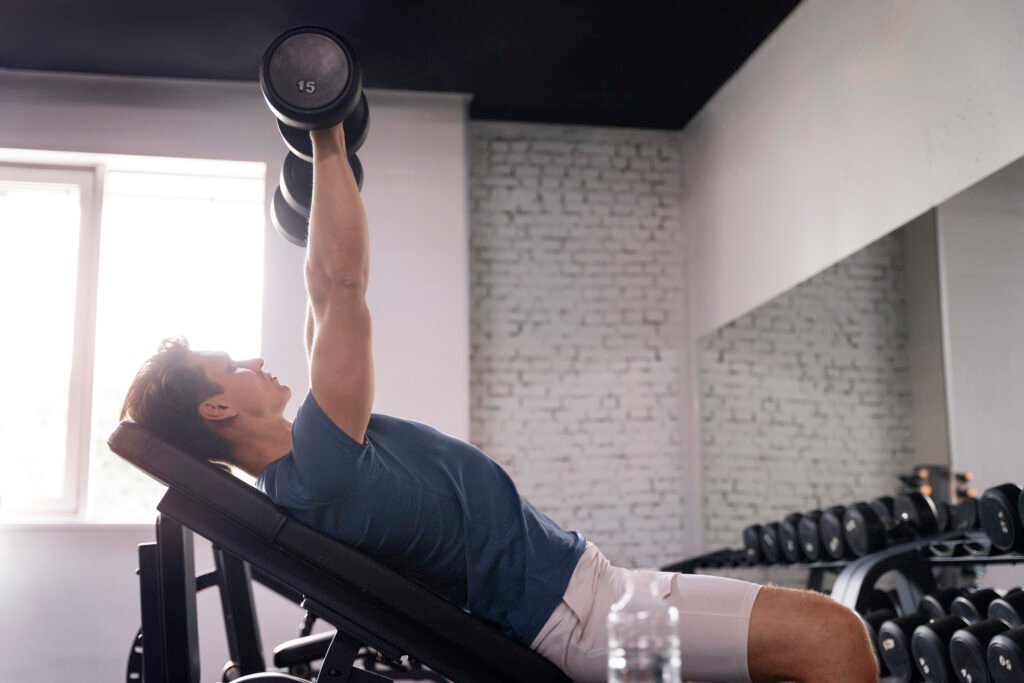Shoulder Workout Gym: Introduction
Welcome to the realm of shoulder workout gym mastery, where strength meets precision and determination fuels transformation. Embark on a journey that transcends the ordinary, sculpting not just muscles but a testament to your commitment. The shoulders, often overlooked in the symphony of fitness, take center stage as we delve into the art of harmonizing power and grace. This introduction is not just a prelude; it’s a call to arms for those seeking to elevate their gym experience. Picture a canvas where each repetition paints a stroke of resilience, where the clang of weights becomes a rhythmic beat propelling you towards newfound prowess. Shoulder Workout Gym Mastery is more than a routine; it’s a symposium of dedication, a manifesto of sculpting your upper body with precision and finesse. Brace yourself as we unravel the secrets, dispel myths, and guide you through a transformative odyssey of shoulder mastery. Get ready to redefine not just your physique but your entire fitness narrative.
Unveiling the Marvels: The Intricate Anatomy of the Shoulders

The shoulders, often overlooked in their complexity, are unsung heroes of human anatomy, enabling a remarkable range of motion and functionality. Comprising a network of bones, joints, muscles, and tendons, the shoulders are a biomechanical masterpiece that deserves our attention. Let’s embark on a journey through the anatomy of the shoulders, unraveling the intricacies that make them a vital component of our daily lives.
Bones of the Shoulders:
At the core of shoulder anatomy are three key bones: the clavicle (collarbone), scapula (shoulder blade), and humerus (upper arm bone). The clavicle provides structural support, connecting the sternum to the shoulder, while the scapula serves as the foundation for the shoulder joint. The humerus, with its rounded head, articulates with the scapula, forming the ball-and-socket joint crucial for arm movement.
Joints and Their Movements:
The shoulder joint, also known as the glenohumeral joint, is a highly mobile ball-and-socket joint. Its design allows for an extensive range of movements, including flexion, extension, abduction, adduction, internal rotation, and external rotation. This versatility makes the shoulders integral in activities ranging from lifting and reaching to throwing and hugging.
Muscles at Work:
A network of muscles orchestrates the intricate dance of shoulder movements. The rotator cuff, consisting of four muscles—the supraspinatus, infraspinatus, teres minor, and subscapularis—plays a pivotal role in stabilizing the shoulder joint. These muscles work harmoniously to ensure smooth and controlled motion while preventing dislocations or injuries.
The deltoid muscle, forming the rounded contour of the shoulder, aids in lifting the arm and provides overall shoulder strength. Additionally, the trapezius, rhomboids, and serratus anterior muscles contribute to shoulder stability, posture, and the coordination of complex movements.
Tendons and Ligaments:
Tendons and ligaments weave through the shoulder, connecting bones and providing structural support. The tendons of the rotator cuff attach muscles to bones, facilitating movement and stability. Ligaments, on the other hand, connect bones to bones, reinforcing the shoulder joint and preventing excessive movement.
Challenges and Common Issues:
Despite their remarkable design, shoulders are prone to various challenges. Overuse, trauma, or age-related wear and tear can lead to conditions like rotator cuff injuries, frozen shoulders, or dislocations. Understanding the anatomy of the shoulders is crucial in addressing these issues through targeted exercises, physical therapy, or, in severe cases, surgical interventions.
Read Also: Health and Safety at Work Act: Navigating the Workplace Terrain
Shoulder Sculpt: Unveiling the Marvelous Benefits of Well-Developed Shoulder Muscles

In the realm of physical fitness, the allure of chiseled abs and sculpted biceps often steals the spotlight. However, one area that deserves its share of admiration is the shoulders. Beyond the aesthetic appeal, well-developed shoulder muscles contribute significantly to overall health and functional fitness. Let’s explore the remarkable benefits that come with dedicating time and effort to shoulder development.
Enhanced Posture:
Well-developed shoulder muscles play a pivotal role in maintaining proper posture. Strong shoulders provide a sturdy foundation for the spine, reducing the risk of slouching or having rounded shoulders. Improved posture not only exudes confidence but also prevents back and neck pain caused by poor alignment.
Increased Upper Body Strength:
The shoulders act as a bridge between the arms and torso, serving as a central hub for upper-body strength. A robust shoulder complex supports various upper-body movements, including pushing and pulling exercises. Strong shoulders contribute to increased bench press capabilities, enhanced pulling strength, and overall upper body power.
Injury Prevention:
Well-conditioned shoulder muscles act as a natural armor, providing stability to the shoulder joints and reducing the risk of injury. Strengthening the rotator cuff muscles, in particular, helps safeguard against common shoulder issues such as impingement and instability. This is especially crucial for athletes and fitness enthusiasts engaged in repetitive overhead movements.
Functional Fitness:
The shoulders are involved in a myriad of everyday activities, from lifting groceries to reaching for items on high shelves. Well-developed shoulder muscles enhance functional fitness by improving the ease and efficiency with which we perform these daily tasks. Whether you’re an office worker or an avid gardener, strong shoulders make life’s activities more manageable.
Aesthetic Appeal:
Let’s not overlook the aesthetic aspect. Well-defined shoulder muscles contribute to a symmetrical and balanced physique. Sculpted shoulders not only enhance the V-taper, creating a visually appealing silhouette, but they also complement other muscle groups, such as the chest and arms, to create a harmonious overall physique.
Boosted Metabolism:
Engaging large muscle groups, such as the deltoids and trapezius, during shoulder workouts can elevate the metabolism. As these muscles require significant energy for both the workout and post-exercise recovery, incorporating shoulder exercises into your routine can contribute to calorie burning and weight management.
Back and Shoulder Workout Gym:

Embarking on a fitness journey often involves a well-rounded approach to building strength and enhancing the overall physique. While many focus on the mirror muscles, such as the chest and biceps, a comprehensive back and shoulder workout is the secret weapon for achieving a balanced, powerful, and aesthetically pleasing physique. Let’s dive into a short yet effective routine that will leave your back broad and your shoulders sculpted.
Deadlifts: The Backbone of Strength
The deadlift is the unsung hero of any back workout. It engages multiple muscle groups simultaneously, including the lower back, glutes, and hamstrings. Not only does it contribute to a strong posterior chain, but it also improves posture and core stability. Incorporate both conventional and sumo deadlifts into your routine to target different areas of your back.
Pull-Ups: Elevate Your Back Game
A classic but often underestimated exercise, pull-ups are a staple for developing a wide and well-defined back. They target the lats, rhomboids, and traps, creating that coveted V-taper. If regular pull-ups are too challenging, start with assisted variations or use resistance bands. Gradually increasing your pull-up prowess will lead to a more sculpted upper body.
Bent Over Rows: Precision in Motion
Bent-over rows are a compound movement that targets the middle and upper back, emphasizing the lats and rhomboids. This exercise not only builds size but also enhances muscle definition. Maintain proper form by hinging at the hips and keeping the back straight. Experiment with different grip widths to stimulate various parts of your back.
Shoulder Press: Elevate Your Shoulders Literally
No back-and-shoulder workout is complete without dedicated shoulder exercises. The shoulder press is a fundamental movement that targets the deltoids. Whether performed with a barbell, dumbbells, or a machine, this exercise contributes to broader shoulders and a more balanced upper body appearance. Focus on controlled movements to maximize the effectiveness of each repetition.
Shoulder Workout Gym: Essential Shoulder Exercises

Overhead Press
Technique and Form: Break down the proper form for the overhead press and its variations.
Variations (Dumbbell, Barbell, Machine): Explore the pros and cons of different overhead press variations to cater to various fitness levels.
Lateral Raises
Targeting the Lateral Deltoids: Understand the importance of lateral raises and how they isolate and develop the lateral deltoids.
Importance of Proper Form: Emphasize the significance of maintaining proper form to avoid injuries.
Front Raises
Engaging the Front Deltoids: Uncover the benefits of front raises in targeting the front deltoids.
Avoiding Common Mistakes: Highlight common mistakes and how to correct them for optimal results.
Rear Deltoid Exercises
Importance for Overall Shoulder Development: Discuss the often neglected rear deltoids and their crucial role in achieving well-rounded shoulders.
Effective Rear Deltoid Movements: Introduce effective exercises to target and strengthen the rear delts.
Shoulder Workout Gym: Creating a Shoulder Workout Routine
Frequency and Volume
Guide readers on how often to train shoulders and the optimal volume for their individual goals.
Balancing Shoulder Exercises
Discuss the importance of a balanced approach, ensuring equal attention to all three heads of the deltoids.
Incorporating Progressive Overload
Explain the concept of progressive overload and its application in shoulder workouts for continual growth and strength gains.
Shoulder Workout Gym: Mistakes You Must Sidestep
Neglecting Warm-Up Rituals:
Picture this: you stroll into the gym, ready to conquer the world, and head straight for the weights. This impulsive move can be a recipe for disaster. Skipping warm-up exercises is a cardinal sin in the fitness world. Ignoring proper warm-up routines leaves your shoulder muscles unprepared for the impending stress, increasing the risk of strains and injuries. Spend a few extra minutes on dynamic stretches and light cardio to awaken those dormant muscles before diving into the main workout.
Overlooking Form for Weight:
In the realm of weightlifting, the allure of heavier dumbbells and barbells is undeniable. However, prioritizing weight over form is a classic blunder. Incorrect form not only diminishes the effectiveness of your workout but also puts your shoulders at risk. Focus on controlled movements, proper posture, and a full range of motion. Gradually increase the weight as your strength and technique improve.
Excessive Volume, Insufficient Recovery:
More is not always better. Excessive volume and inadequate recovery time can lead to overtraining, a common pitfall in shoulder workouts. Your shoulder muscles need time to heal and grow stronger. Striking a balance between workout intensity and recovery is crucial. Consider incorporating rest days into your routine, along with activities like foam rolling and stretching, to alleviate muscle tension.
Ignoring Rotator Cuff Exercises:
The rotator cuff plays a pivotal role in shoulder stability, yet it’s often overlooked in favor of more glamorous exercises. Neglecting rotator cuff workouts is a mistake that can haunt you later on. Integrate targeted exercises like external rotations and lateral raises to fortify the muscles surrounding the shoulder joint. This not only enhances stability but also reduces the risk of injuries.
Monotonous Routine Syndrome:
Repeating the same shoulder-workout gym routine ad nauseam is a surefire way to hit a plateau. Your muscles adapt to familiar stimuli, limiting growth and progress. Introduce variety into your workouts by incorporating different exercises, changing rep ranges, or experimenting with training techniques. Keeping your muscles guessing ensures continuous improvement.
Shoulder Workout Gym: A Nutritional Blueprint for Shoulder Muscle Development

Achieving well-defined and robust shoulder muscles requires more than just hitting the gym consistently. Nutrition plays a pivotal role in supporting muscle growth, strength, and recovery. Whether you’re a seasoned lifter or a fitness enthusiast looking to sculpt your shoulders, understanding the right nutrients can make a significant difference in your journey toward well-developed deltoids.
Protein Power:
Protein is the cornerstone of any muscle-building diet, and the shoulders are no exception. Aim for a protein-rich diet that includes sources like lean meats, poultry, fish, eggs, and plant-based options like tofu and legumes. Protein provides the essential amino acids necessary for muscle repair and growth, making it crucial for those striving for sculpted shoulders.
Omega-3 Fatty Acids:
Inflammation can hinder muscle recovery and growth. Omega-3 fatty acids, found in fish oil, flaxseeds, and walnuts, possess anti-inflammatory properties that aid in reducing muscle soreness and promoting a healthier environment for muscle development. Including these healthy fats in your diet not only supports shoulder muscle growth but also contributes to overall joint health.
Carbohydrates for Energy:
Don’t neglect carbohydrates in your quest for shoulder gains. Carbs are the body’s primary energy source, and intense shoulder workouts demand a significant amount of energy. Opt for complex carbohydrates like whole grains, brown rice, and sweet potatoes to sustain your energy levels throughout your training sessions. Adequate energy ensures that you can push through each set with intensity, ultimately leading to better muscle stimulation.
Hydration Matters:
Staying hydrated is often overlooked but is crucial for optimal muscle function and recovery. Water supports nutrient transportation, helps regulate body temperature, and aids in joint lubrication. Aim to drink enough water throughout the day, especially before and after your workouts, to keep your shoulders functioning at their best.
Micronutrients for Recovery:
Vitamins and minerals are essential for overall health and play a vital role in muscle recovery. Vitamin C, found in citrus fruits and bell peppers, promotes collagen synthesis, aiding in the repair of connective tissues around the shoulder joint. Minerals like magnesium and zinc, present in nuts, seeds, and leafy greens, contribute to muscle function and protein synthesis.
Shoulder Workout Gym: Conclusion
Summarize the essential elements discussed, reinforcing the importance of a holistic approach to shoulder development.
Motivate readers to stay consistent in their shoulder training for long-term success.
Inspire readers to embark on their journey to shoulder gym mastery, fostering strength, symmetry, and confidence.
